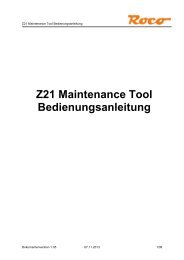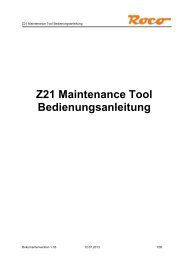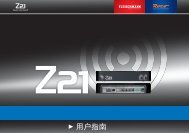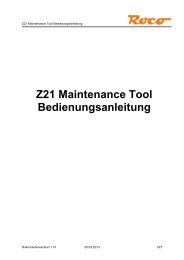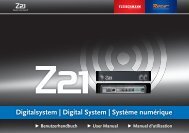Digitalsystem | Digital System | Système numérique - Z21
Digitalsystem | Digital System | Système numérique - Z21
Digitalsystem | Digital System | Système numérique - Z21
- No tags were found...
You also want an ePaper? Increase the reach of your titles
YUMPU automatically turns print PDFs into web optimized ePapers that Google loves.
Loops in <strong>Digital</strong> OperationNote: To make sure that the loopmodule responds quickly enough,the sensitivity must be set prior tooperation using the potentiometervisible at the side. Observe operatinginstructions.4. Loops in <strong>Digital</strong> OperationEvery DC railway enthusiast knows the following problem: if after a loop, the left rail profile meets theright one, a shortcircuit occurs without the appropriate wiring.With our loop modules (Art. No. 10767 or 10769), this switching problem in digital operation is elegantlytaken care of: simply separate the loop on both sides on two poles and insulate the rest usinginsulated connectors (Art. No. 42611, 61192, 6433 or 9403) electrically from the remainder of thelayout (see Page 49). The separated layout portion within the loop must be longer than the longesttrain which is to drive through the loop. The power to the loop is supplied by the loop module whichis connected either to the track outside the loop or to the <strong>Z21</strong> <strong>Digital</strong> Centre.And this is how the loop module works: as soon as a train enters the loop regardless of the direction,shortcircuit detection occurs in the module. The polarity in the loop is automatically changed beforethe shortcircuit detection of the <strong>Digital</strong> Centre is aware of it or before the trains slows down. Thepolarity reversal is repeated when the train leaves the loop. Thus, the train can pass through a loopwithout stopping or operator intervention.48



